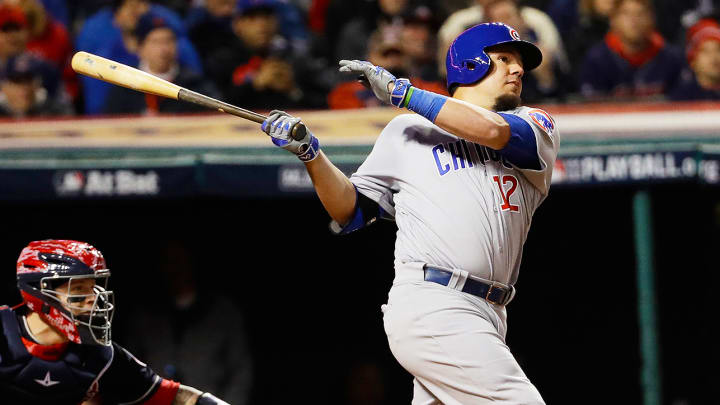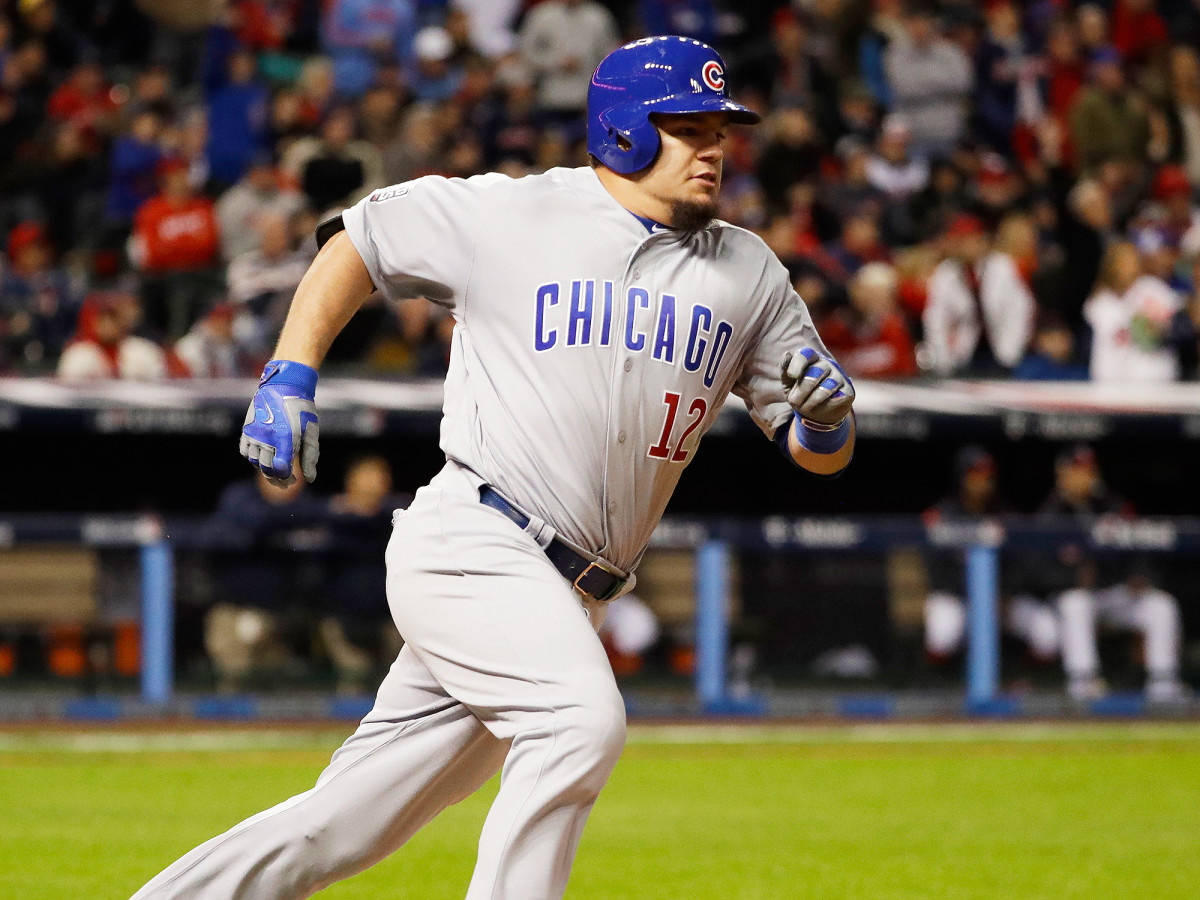Kyle Schwarber’s successful return a silver lining for Cubs in Game 1 loss

CLEVELAND—“When will it be ready?” Kyle Schwarber asked his doctor back in April.
“Spring training,” the doctor replied.
“How about now?” Schwarber would ask again, every month or two, between grueling rehab sessions in which therapists would strap him to a table and manually bend his stiff limb, and in which he had to limp his way to relearning how to run.
“Spring training,” the doctor would answer.
“It” was the left knee that the Cubs’ burly 23-year-old slugger, who blasted 16 home runs in just 232 at-bats as a rookie last year and five more during the playoffs, ripped up in an outfield collision during this season’s second game. As recently as a week ago, his doctor’s prognosis hadn’t changed. During the NLCS, someone asked starter Jon Lester how his team might be different with a healthy Schwarber. “I can only imagine what our offense would have been like this year,” lamented Lester. “He definitely would have helped in the situation now. But this is the hand we’re dealt.”
Corey Kluber’s masterful Game 1 effort shows why Indians are so dangerous
Lester didn’t know it, but Schwarber’s doctor was about to slide aces across the felt. “When will it be ready?” Schwarber asked, as the rest of his teammates were busy with the Dodgers.
“Now,” the doctor said. “It’s great. You’re strong. I’m not going to hold you back from doing anything.”
Suddenly, spring training had turned into the World Series—maybe. He called Theo Epstein, the Cubs’ president of baseball operations, with the news. “I’d love the opportunity to try,” he said. “Knowing that I have the opportunity to try and get back, it would kill me deep down inside if I didn't.”
Schwarber went to the Cubs’ facility in Arizona and tracked 1,300 pitches from a pitching machine, twisting its dials all the way to the right. “I tried to set it to the nastiest setting that I could, to where it would be a really sharp break, just to train my eyes all over again,” he says. Though eight blisters bubbled on his uncalloused hands, his knee felt good.
• The World Series impact Danny Salazar and Kyle Schwarber could have
On Saturday, he played his first game in 6 1/2 months, for the Mesa Solar Sox of the Arizona Fall League, in front of about 100 fans who sounded, to him, like crickets. He went 0 for 3 with a walk, then watched on a iPad in the dugout as the Cubs put away the Dodgers in Game 5 of the NLCS in Los Angeles, and he screamed and sprayed champagne, 370 miles away.
On Monday, he played his second game, going 1 for 3 with a walk and a resounding double. He had already packed his bags. The charter he boarded was the third private flight he’d ever taken; the previous two were to transport him to and from his surgery. As the plane roared towards Cleveland, he tried to stream The Blacklist, but the plane’s WiFi wasn’t working well enough. He tried to play Sudoku, but he couldn’t concentrate. “I sat in a chair, and about a million thoughts ran through my head,” he says. “Three hours felt like five.”
Indians, Cavaliers creating a winning culture in the city of Cleveland
On Tuesday, after a virtually sleepless night, Schwarber found his name inked into the fifth spot in the Cubs’ lineup as the designated hitter for what would be his third game back: Game 1 of the World Series. “But for his special talent and character, we’d have probably found a way to not have this happen,” Epstein said of the decision. Even though Schwarber was a slugger without a natural position in a league that normally prohibits designated hitters, and even though he had a damaged knee, Epstein had refused to even consider trading him this summer for healthy reinforcements. The potential for a night like this was why.
In his first at-bat, Schwarber—who was so emotional that he nearly wept during the national anthem—struck out against Indians’ ace Corey Kluber. His nerves had settled by his second: He crushed Kluber’s first pitch, a 91-mph sinking fastball, some 378 feet to the base of the wall in right-centerfield, for a double that would have cleared the fence if not for a stiff Cleveland wind. Perhaps even more impressive, though, was what he did with his third at-bat.

Before the game, Cubs manager Joe Maddon previewed what he would be looking for in Schwarber’s performance. “The biggest thing, obviously, even more than hitting a fastball tonight, would be, How do you react to off-speed pitches?” he said. “And not to hit the off-speed pitch, to take the one that’s a ball. That’s probably the most important thing that he’ll be able to do tonight, is to know when to not swing.”
Schwarber’s third plate appearance, in the top of the seventh, came against a reliever who not only has the game’s best breaking ball, but who also had issued a walk to a lefthanded hitter, like Schwarber, just once this entire year: Andrew Miller. Schwarber had never before faced Miller, who threw him five beastly sliders of a quality that no pitching machine could simulate. The fifth came on a full count, and it veered in low; Schwarber didn’t swing. He became the second lefty to walk against Miller in 2016.
Andrew Miller: Inside his journey to a new type of October dominance
When Schwarber walked to home plate for a fourth time to face Miller again in the top of the eighth, the game was still in reach. The Indians led 3–0, but the Cubs had somehow managed to put men on first and third with two outs. Schwarber got ahead of the relief ace again, 2–1, and then, against another slider, he unleashed the swing that the Cubs had been waiting for, but thought they wouldn't see again until 2017: a whistling cut that nearly twirled his 235-pound body around, one that promised to send the ball so deep that no Lake Erie wind could stop it.
Schwarber swung through that pitch, then swung through the next one. The Indians would score three more times in the bottom of the frame, on a three-run homer by unlikely hero Roberto Perez, and the Cubs would lose Game 1 by the score of 6–0.
After the game, as water from the shower still glistened in his steel-wool goatee, Schwarber explained what the game had meant to him. He had felt comfortable at the plate, even against two of the game’s best pitchers, Kluber and Miller. His knee felt fine. “Now that I’m here, I don’t got anything to lose,” he said. “I’m just going to throw it on the line.
• Timeline: In-depth look at the Cubs’ history and championship drought
“I can hound myself for not getting a hit against Miller in that at-bat with two guys on, but that’s baseball,” he added. “It’s going to happen. You've just got to move on to the next day.”
Suddenly, and before anyone thought possible even a week ago, Schwarber is back to having next days to which to look forward. He was asked if he had put something extra into that mighty hack against Miller. “Oh no,” he said, and then waited for the reporters who gathered around his locker to laugh. “That’s a normal swing.”
“I think he’ll have a moment where he does something special,” said Epstein, of his restored phenom, before the game. The moment almost happened in Game 1. Even though the Cubs lost, the defeat had the silver lining, brilliantly gleaming, that it is coming.
